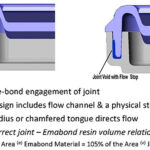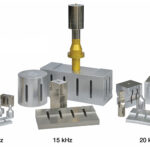by Steven M. Chookazian, Emabond Solutions, LLC What is electromagnetic welding? Electromagnetic welding, also more commonly known as the Emabond Process, is a design and assembly method that provides a simple, rapid and reliable assembly technique to produce structural, hermetic or high-pressure welds on most thermoplastic materials and TPEs. It employs the basic principles … [Read more...] about Q&A: Electromagnetic Welding of Plastics
Welding
Five Factors Influencing a Successful Ultrasonic Weld
by Brian Gourley, Sonics & Materials, Inc. The basic principle of ultrasonic assembly involves conversion of high-frequency electrical energy to high-frequency mechanical energy in the form of reciprocating vertical motion, which, when applied to a thermoplastic, can generate frictional heat at the plastic/plastic or plastic/metal interface. In ultrasonic welding, … [Read more...] about Five Factors Influencing a Successful Ultrasonic Weld
The Principles of Ultrasonic Welding
by Steven A. Williams, Branson Ultrasonics, a business of Emerson Ultrasonic welding is a process used to join two plastic parts together to form a strong, finished assembly. The process relies on high-frequency (ultrasonic) vibrations being generated and applied to the parts via a horn. Welding occurs as the vibrations are absorbed in the interface between the two parts, … [Read more...] about The Principles of Ultrasonic Welding
Ultrasonic Welding: Your Canary?
By Tom Kirkland, tributek.biz . A recent SPE TECH CHAIN post mentioned a molding problem that began with a resin dryer which was not functioning properly. This resulted in charring of the material in a corner of the mold because of outgassing. The molding technician then turned down the barrel heat, which resulted in both excessive shear damage (not noticed) and short … [Read more...] about Ultrasonic Welding: Your Canary?
When Vibration Welding is the Best Choice
by Jeffrey Frantz, Branson Vibration welding has been a process of choice for quite some time in applications that have complex geometries, especially for materials that are difficult to weld, such as glass-filled nylon, polypropylene and polyethylene. Typical applications include, but are not limited to, automotive air conditioning ducts, power steering and brake … [Read more...] about When Vibration Welding is the Best Choice







